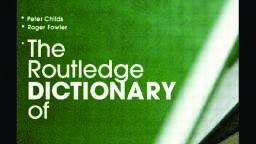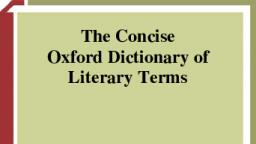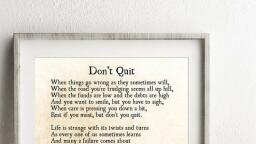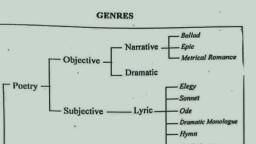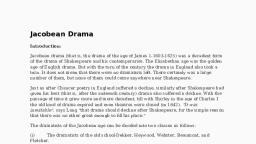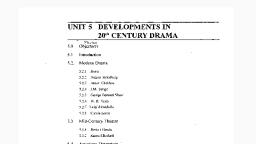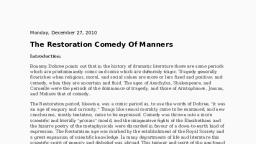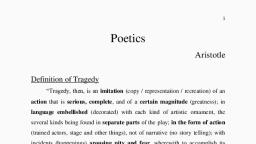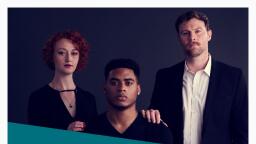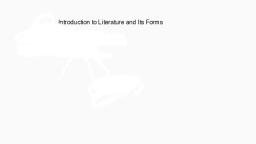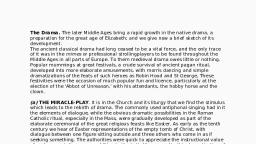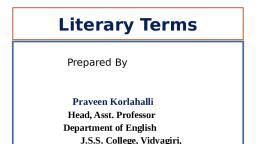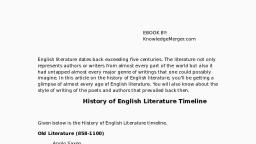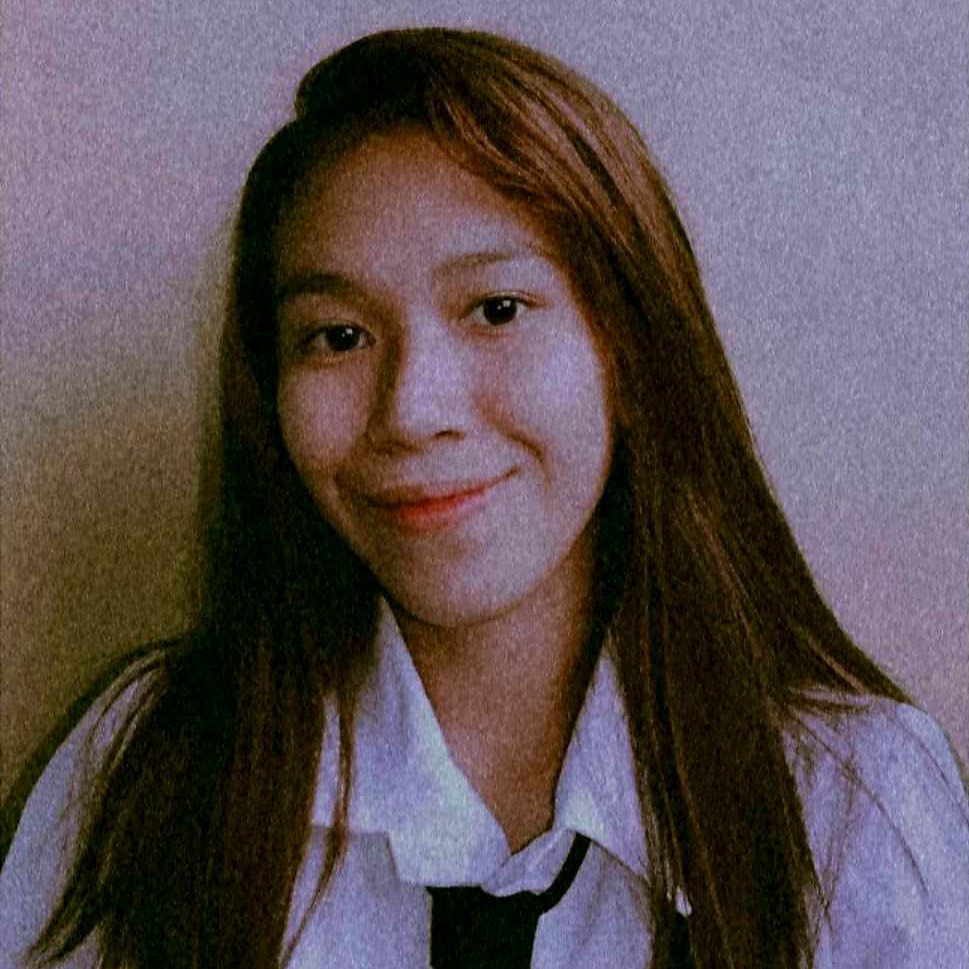Page 2 :
What is a drama?, What are the elements of drama?, , What are the dramatic devices?, What are the types of drama?
Page 3 :
So far as the first point is concerned, Drama is one of the forms of literature. We also use, the word “play” for drama., It is a story with dialogues and actions., It is meant to be performed in front of an audience by, actors who take on the roles of characters., , Its full qualities are revealed when it is perfomed on, stage., Its a collaborative work. The dramatist works with, director, producer, actors, dress makers, musicians,, electricians, scene painters and many others.
Page 4 :
The elements of drama are, , , Plot, , , , Character, , , , Theme, , , , Setting
Page 5 :
The first is Plot, , , , , , , , , Plot is the arrangement of events of the story., This arrangement, relationship., , has, , a, , cause, , and, , effect, , In a drama, the plot is in the form of scenes and, acts. The typical Elizabethan drama was devided, into five acts each comprising a number of scenes., But, in a modern drama, we find three acts., Moreover, we can also have a one act play., , According to the type of drama, the plot may vary., Sometimes it has a single main plot. But, it can also, have sub plots.
Page 6 :
, , , , , , , , The plot begins with some event and leads to the, next event and so on., , The plot often contains details of conflict or tension, that exists between the characters., When the conflict reaches its highest point it is, called climax., When the conflict comes to an end it is called, resolution.
Page 7 :
After plot we have Character, , , , , , , A drama deals with people and their actions which, are called as characters. These characters may be, humans as well as non humans like animals and, supernatural figures., The way a writer describes people is known as, characterization., While studying a character we should consider his, physical appearance, dress, behaviour, expressions, or speech, relation with others, mannerisms and, names even nick names
Page 8 :
, , , , , , , , In a drama, the actors present the characters. The, costumes and make ups also help in potraying the, characters., In addition, we learn more about them by what, they say and what others say about them., Characters who change with the development of, plot are known as round characters., Characters who do not change with the, development of plot and remain the same, throughout the story are known as flat characters.
Page 9 :
, , , , , , Among the characters someone may be the most, important such a character is called hero heroine or, protagonist., The protagonist is usually in conflict with another, character known as antagonist or the villain., The characters around whom the action of drama, revolves are major characters. Apart from them, many minor characters contribute to the, development of the plot.
Page 10 :
, , , , , , Characters can also be classified as types and, individuals, Types or typified characters represnt a class and are, typical. They are generally the minor characters., Individuals are opposite of the types and are, complex. They are generally the major characters.
Page 11 :
The next element is Theme, , , Theme is the idea on which a literary work is based., , , , In other words it is the subject of a play., , , , , , , , , , A play may have multiplicity of themes which, means it may have more than one theme., The dramatist may use certain symbols and motifs, to convey these themes., , Motifs are recurring structures, images and, contrasts in a play., Symbols are objects, characters, figures, and colors, used to represent abstract ideas or concepts.
Page 12 :
Setting, , , , , , , , , , , Setting is where and when the story takes place. So,, it is the place and time of the events of story., Apart from geographical and historical setting, the, social setting of a play is also important., , Setting affects the behaviour of a character and, thereby the action of a play., Setting also has a correlation with the theme of a, play., In a drama, setting is shown on stage through, scenery and reference. The use of lights and, sounds is quite important to create a spectacle.
Page 13 :
Now lets move to Dramatic Devices, , , , , Dramatic irony is a form of contrast. Often what is, being said or done on stage has one meaning for, the characters but another meaning for spectators., There are two tpes of dramatic irony. One is verbal, irony and irony of situation., , , , Verbal irony arises out of what is being said., , , , Irony of situation arises out of what is being done.
Page 14 :
Dramatic Devices, , , , , Dramatic irony is a form of contrast. Often what is, being said or done on stage has one meaning for, the characters but another meaning for spectators., There are two types of dramatic irony. One is verbal, irony. Another is irony of situation., , , , Verbal irony arises out of what is being said., , , , Irony of situation arises out of what is being done.
Page 15 :
, , , , , , , , Next dramatic device is Soliloquy. It is the act of, talking to oneself. The character speaks out his, heart on stage when other characters are not, present. It acquaints the audience with the, character's motives and state of mind., Aside is the shortest form of soliloquy. It is a, passing thought uttered aloud by a character in, front of other characters but they do not hear it., Expectation and surprise are the dramatic devices, related to plot construction., When all relevant facts are disclosed at once and, the subsequent development of events is as per, anticipation, it is called expectation.
Page 16 :
•, , , , , , , , When a few facts are heldback for sometime to be, sprung on the audience later and the intrest is, derived from suspence, it is called surprise., Too much of expectation leads to dullness whereas, too much of surprise leads to melodrama., While reading a play, we also come accross stage, directions given in the brackets., , Stage directions are not a dramatic device. In the, script of a play, they indicate the lines a producer, has to follow in order to produce the play as per the, author's intension.
Page 17 :
, , , , , , , , , , In short, what we have discussed till now is the, definition and elements of drama., In it we have talked about the nature of Plot,, Character, Theme and Setting., Among the Dramatic Devices, we have focused on, Dramatic irony, Soliloquy, Aside, Expectation and, Surprise., Finally, we have also touched what Stage Direction, is., Now lets move to the second part of our discussion, that is types of drama.
Page 18 :
Broadly speaking the Types of Drama, are, • Tragedy, , • Comedy, • Tragi-comedy, , • Farce, • Melodrama and, , • Masque
Page 19 :
Tragedy, • From the ancient times drama has been divided into, two kinds – tragedy and comedy., • Of these tragedy deals with the dark side of life., • In the Greek tragedy, the protagonist belonged to, the high class of society. His fate led him towards his, tragedy. His tragedy affected the whole nation., • The atmosphere of tragedy is serious. In pure, tragedies, the mixing of comic elements was not, allowed.
Page 20 :
• But, the English dramatists have experimented with, it and mixed the elements of comedy with tragedy., • For instance, in Shakespeare’s tragedies, we find the, presence of comic elements without affecting the, end effect of tragedy., • The end effect of tragedy or the aim of tragedy is, purgation or purification of feelings. This is known as, Catharsis., • Catharsis is a Greek word. It is used by Aristotle in, his book Poetics while talking about the theory of, tragedy.
Page 21 :
• Tragedy is classified in two ways. One is with, reference to its form and another is with reference, to its theme., • As per the forms tragedy is either classical tragedy, or romantic tragedy, • Classical tragedy is based on the Greek model. It, follows the three unities of time, action and place. It, also makes use of Chorus., • Chorus is a group of factors who report what, happened off the stage and make moral comments, from time to time., • Classical tragedy tries to strengthen the religious, convictions of the audience.
Page 22 :
• Romantic tragedy doesn’t have a set pattern. The, writer uses the form as per the requirement of his, dramatic purpose., • It is opposed to classical tragedy in the way that it, doesn’t necessarily maintain the three unities. It, doesn’t employ Chorus. Its not didactic., • From the theme or matter point of view there can, be many types of tragedy depending upon the, variety of subjects. Horror tragedy, Heroic tragedy,, She tragedy, Domestic tragedy etc.
Page 23 :
• Horror tragedy deals with violence and cruelty. It is, also known as Revenge tragedy. It follows the Greek, model of Seneca. In English, John Webster’s dramas, are read as horror tragedies., • Heroic tragedy deals with the exploits of a sublime, hero. Sometime, they are written in verse. In, English, John Dryden has written this kind of, tragedies., • She tragedy has a female protagonist. It is also, known as Pathetic tragedy. It explores the sufferings, of a woman. This kind of tragedy was popular during, restoration period. Nicolas Rowe provides some, finest examples of She tragedies
Page 24 :
• Domestic tragedy was popular during the 18th, Century. It portrays the middle class life using prose., As opposed to classical tragedy, Domestic tragedy, uses characters and incidents of ordinary life as the, subject of serious drama. George Lillo’s London, Merchant is a famous example of Domestic tragedy., • Like tragedy, comedy also has two forms- Classical, and Romantic., • Classical comedy observes all the classical rules of, comedy as dealing with the light side of life, having, lower people as the characters, having a comic, atmosphere and a happy ending.
Page 25 :
• Ben Jonson and the restoration playwrights wrote, classical comedies., • Romantic Comedy doesn’t follow the classical rules, of comedy. Shakespeare and the University Wits, wrote Romantic comedies., • Depending on the subject there are many types of, comedies like Comedy of Humours, Comedy of, Intrigue, Comedy of Manners, Sentimental Comedy., • Comedy of Humours is developed by Elizabethan, playwright, Ben Jonson. It is based on the ancient, theory of four Humours or temperaments.
Page 26 :
• It is believed that human body has four primary, fluids. They determine a person physical condition, and type of character. Ben Jonson’s Every Man in His, Humour is the best example of it., • Comedy of Intrigue is also known as Comedy of, Situation. It was popular specially during the, restoration period. It deals with complicated plots,, conspiracies and situation arising out of, unfaithfulness in love and marriage. Shakespeare’s, Much Ado About Nothing is considered as Comedy, of Intrigue.
Page 27 :
• Comedy of Manners is also known as Restoration, Comedy. It criticises the manners of high class, society. The language and behaviour of the, characters is highly stylish and artificial. William, Congreve’s The Way of the World is an example of, it., • Sentimental comedy presents melodramatic, situation. It came as a reaction to the immoral tone, of Restoration Comedy. It generally has a middle, class protagonist. It aims at producing tears rather, than laughter. Richard Steele’s The Conscious Lovers, can be put forward as a instance.
Page 28 :
• Satiric Comedy ridicules political policies or, philosophical doctrines. It attacks deviations from, social order. The Greek dramatist Aristophanes, wrote this kind of drama. Ben Jonson calls it, Corrective Comedy., • Tragi Comedy is the next type of drama. It, originated during the Elizabethan period. It, combines the features of Tragedy and Comedy. It is, a Tragedy with a comic relief and a Comedy with, tragic background. The rising action is tragedy and, the following action is comedy. In other words, it, begins with tragedy and ends with comedy., Shakespeare’s Winter’s Tale and The Tempest are, the examples.
Page 29 :
• Farce is a exaggerated form of comedy. It is meant, for laughter. It is far away from real life. It makes, use of highly exaggerated or caricatured characters., The situation are improbable and hard to believe. In, English drama, Farce is used as an episode in the, comedy. The modern dramatists employ it in the, theatre of absurd. Some of the scenes in, Shakespearean comedies have the Farcical element, in them., • Melodrama is a lower form of tragedy. Music was, the essential element of a melodrama, but later on, sentiments and sensational actions became more, important.
Page 30 :
• Though, we can trace the elements of melodrama in, earlier plays, melodrama became especially in the, Victorian period. Melodramas have wonderful, scenic devices representing major calamities on, stage., • Masque is also a play with music, elaborate scenic, effects and dancing. It generally has a fairy tale, a, myth or an allegory as its base for the story. This, kind of drama originated in Italy. In England it was, introduced in the 16th century. It makes use of, elaborate costumes and dancing. John Milton’s, Comus is an example of English Masque., Shakespeare used Masque partially in his play The, Tempest.
Page 31 :
• One Act Play is as old as Mystery and Miracle plays., The Interlude of 15th century was also a One Act, Play., • One Act Play is like a short story. It imposes many, restriction on the dramatist. Brevity is the soul of, One Act Play. The plot of One Act Play is simple. It, generally conveys one theme., • It is either a comedy or a tragedy and conveys single, emotion., • The success of One Act Play depends on simplicity of, design and immediate impact.
Page 32 :
• Miracle plays, Morality plays and Interludes are, types of Medieval drama. They were written in a, variety of verse forms., • Miracle play was generally based on a story from the, Bible or on the life of some saint. Initially they were, sponsored by the Church and were didactic in, nature., • Morality plays were also based on the Christian, beliefs. They followed the allegorical form. The, characters were personifications of virtues, vices,, angles and demon. The best known morality play is, Everyman.
Page 33 :
• Interludes are a variety of short stage, entertainments. In the late 15th and early 16th, centuries interludes were perform by bands of, professional actors. They were often enacted in, between the courses of a feast or between the acts, of a longer play. John Heywood’s farces of the first, half of 16th century are the best example of, interludes., • Historical Plays are also known as Chronicle Plays., Christopher Marlowe’s Edward II is an example of it., Generally these plays are based on Historical, materials such as Holinshed’s Chronicles.
Page 34 :
• This kind of plays were popular in the 16th century, England. They deal with people and events from, English History., • Shakespeare’s Richard II, Henry IV, Henry V, Julius, Caesar are the History plays or Chronicle plays., • Dear students, as part of types of drama we have, focused on tragedy and its different types such as, Classical Tragedy, Romantic tragedy, Horror tragedy,, Heroic Tragedy, She Tragedy, comedy and Domestic, Tragedy.
Page 35 :
• In case of Comedy we have seen Classical Comedy,, Romantic Comedy, Comedy of Humours, Comedy of, Intrigue, Comedy of Manners, Sentimental Comedy, and Satiric Comedy., • I would like to remind you that we have also, discussed some other types of drama like Farce,, Melodrama, Masque, One Act Play, Miracle Play,, Morality Play, Interludes and Historical Plays., • Now, Lets complete our discussion by including, some of the modern types of dramas. Problem play, is one of them in it a social problem is discussed., The Author doesn’t provide any solution but leaves, the audience to decide. G B Shaw is the major, practitioner of this kind of plays.
Page 36 :
• The most prominent form of modern drama is, Absurd drama. After the World Wars some of the, thinkers have an opinion that Human life is, meaningless and Absurd. Albert Camus who was an, existentialist Philosopher expresses the same, opinion in his book Myth of Sisyphus., • Absurd drama makes use of black humour and flat, characters to convey the meaninglessness of Human, existence. The dialogues are abrupt and don’t follow, any logical sequence. The action are repetitive. The, loneliness and dehumanization in a commercialized, world are the major themes.
Page 37 :
• Samuel Beckett’s Waiting for Godot, Harold Pinter’s, Birthday Party, Tom Stoppard’s Jumpers, Edward, Albee’s The Zoo Story are the popular examples of, Absurd play., • Expressionistic drama is another modern, development. Expressionism is German movement, in Literature and in other Arts. As opposed to the, tradition of Realism, the Expressionist artist, expresses a personal vision of Human life and, Human society. This is done by exaggerating and, distorting the excepted features of the World.
Page 38 :
• In drama, Eugene O’Neill made use of expressionism, or expressionistic techniques. For instants, in the, play The Hairy Ape he focuses on what in going on in, the mind of the protagonist. The use of lights and, sound effects helps the dramatist in achieving the, goal., • Bertolt Brecht’s plays are read as the plays of epic, theatre. He was a German playwright. He gave the, concept of alienation effect which is closer to, defamiliarization of the Russian formalists. It is seeks, the dramatists to have a critical distance from the, audience. They present social reality as something, strange.
Page 39 :
• In epic theatre, the social reality is presented in such, a way that the audience are aroused to criticise and, take action against it rather than simply accepting it., In these plays the audience not only have sympathy, for the actors but also identify themselves with the, actors and thus are encouraged to take their roles., • Thus among the modern types of drama we have, talked about problem plays, absurd plays,, expressionistic plays and the epic theatre




